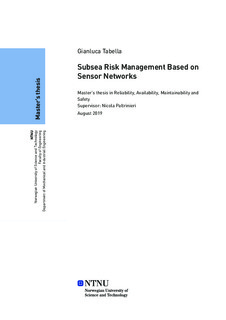| dc.contributor.advisor | Paltrinieri, Nicola | |
| dc.contributor.author | Tabella, Gianluca | |
| dc.date.accessioned | 2019-11-01T15:00:26Z | |
| dc.date.available | 2019-11-01T15:00:26Z | |
| dc.date.issued | 2019 | |
| dc.identifier.uri | http://hdl.handle.net/11250/2626172 | |
| dc.description.abstract | Denne masteroppgaven omhandler evalueringen av undervannsrisikostyring for å forhindre oljeutslipp basert på analyse av informasjon mottatt fra sensorer i et underwater distributed sensor network. Oppgaven begynner med en fremheving av viktigheten av et velfungerende lekkasjedeteksjonssystem både fra et miljø- og et sikkerhetsperspektiv. Goliat FPSO betraktes som en casestudie. Gjeldende FPSO er plassert i Barentshavet, hvilket er et sensitivt område og må oppfylle krav diktert av norske myndigheter for å forhindre oljeutslipp. En innovativ teknologi benyttes på denne plattformen for å detektere mulig oljeutslipp under vann: bruken av passive akustiske sensorer. Et sensornettverk slik som dette består av ulike sensorer som sender informasjon (lokal beslutning) til et fusjonssenter som tar en global beslutning vedrørende om lekkasjen pågår eller ikke. Denne oppgaven vil evaluere hvordan valget av ulike fusjonsregler (Counting Rule og Weighted Fusion Rule tilpasset denne oppgaven) kan påvirke yteevnen til lekkasjedeteksjonssystemet i dets gjeldende konfigurasjon. Det vil også bli diskutert hvordan forskjellige terskler, valgt for en spesifikk fusjonsregel eller sensortest, kan endre den endelige yteevnen sett fra et deteksjonsperspektiv. Deteksjonsmetoder baseres på statistisk signalprosessering og beslutningsteori, ofte ved utnyttelse av allerede eksisterende metoder brukt i andre felt (telekommunikasjonsteknologi, medisin, krigsvitenskap), som må tilpasses til dette bruksområdet innen olje -og gassindustrien. Et steg videre er å utvikle en metode som kan lokalisere lekkasjepunktet i en havbunnsramme. Denne oppgaven foreslår noen metoder som kan være nyttige for å lokalisere utstyret ansvarlig for lekkasjen. Disse foreslåtte metodene for lekkasjelokalisering er utviklet så de kan jobbe sammen med de foreslåtte metodene for lekkasjedeteksjon, hvilket vil gi et koherent sett av operasjoner som sensorene og fusjonssenteret må utføre. Yteevnen til deteksjonsteknikkene bestemmes ut ifra en balanse mellom behovet for høyere verdier av parametere som Sanne Positive Rate og Presisjon, og å beholde lave verdier av Falske Positive Rate. Yteevnen til lokaliseringsteknikkene vil bli evaluert ut ifra deres evne til å lokalisere lekkasjepunkter i løpet av kortest mulig tid. Hvis dette ikke er mulig vil andre parametere tas i betraktning, som for eksempel differansen mellom estimert posisjon og faktisk lekkasjeposisjon. Noen flere simuleringer utføres for å teste de foreslåtte lokale og globale tersklene brukt sammen med spesifikke fusjonsregler for deteksjon og lokalisering av lekkasjen. Yteevnen til de ulike konfigurasjonene vil bli rangert i henhold til globale indekser nødvendige for å samle ovennevnte deteksjonsevneparametere. Disse indeksene kan baseres enten på ROC-kurven (som Youdens indeks) eller på PR-kurven (som F-mål). | |
| dc.description.abstract | This thesis consists of the evaluation of subsea risk management against oil spills based on the analysis of information received from sensors in an underwater distributed sensor network. The work starts by highlighting the importance of having a performing leak detection system either from an environmental or safety point of view. The Goliat FPSO is considered as a case study. This FPSO is located in the Barents Sea, which is a sensitive environment and has to meet requirements dictated by Norwegian authorities in order to prevent oil spills. An innovative technology is used on this platform to detect possible subsea oil spills: the use of passive acoustic sensors. A sensor network like the one present here is composed of different sensors which transmit information (a local decision) to a fusion center which takes a global decision on whether the leakage is occurring or not. This work will evaluate how the choice of different fusion rules (Counting Rule and Weighted Fusion Rule adapted for this work) can affect the performances of the leak detection system in its current configuration. Also, it will be discussed how different thresholds, selected for a specific fusion rule or sensor test, can change the final performance from a detection point of view. Methods used for detection are based on statistical signal processing and decision theory, often exploiting methodologies already in use in other fields (telecommunication engineering, medical sciences, military sciences), which have to be adapted to fit this application within the Oil&Gas industry. A further step is to develop a method able to localize the leakage point in a subsea template. This work proposes some methods which could be useful in order to localize the equipment responsible for the leakage. These proposed methods for leak localization are developed so that they can be coupled with the proposed methods for leak detection, giving a coherent set of operations that the sensors and the fusion center must perform. Performances of detection techniques are assessed balancing the need of having higher values of parameters like the True Positive Rate and the Precision, maintaining low values of False Positive Rate. Whereas, performances of localization techniques will be assessed according to their ability to localize leakage points in the shortest amount of time possible; if this is not possible, other parameters like the difference between the estimated position and the real leakage position will be considered. Some other simulations are carried out to test the proposed local and global thresholds coupled with specific fusion rules for detection and localization of the leakage. Performances of the different configurations will be graded according to global indexes necessary to gather together the above-mentioned detection performance parameters. These indexes can be based on either the ROC curve (like the Youden's Index) or the PR curve (like the F-scores). | |
| dc.language | eng | |
| dc.publisher | NTNU | |
| dc.title | Subsea Risk Management Based on Sensor Networks | |
| dc.type | Master thesis | |
